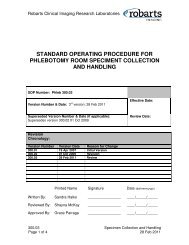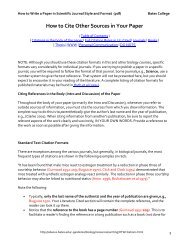How to Give a Scientific Talk, Present a Poster, - Indiana University
How to Give a Scientific Talk, Present a Poster, - Indiana University
How to Give a Scientific Talk, Present a Poster, - Indiana University
You also want an ePaper? Increase the reach of your titles
YUMPU automatically turns print PDFs into web optimized ePapers that Google loves.
Figure 1. Two slides prepared with Microsoft’s PowerPoint showing (<strong>to</strong>p) the simpleversion and (bot<strong>to</strong>m) the same material on a PowerPoint supplied “template” –note that the “chart junk” on the template serves only <strong>to</strong> reduce the area allocated <strong>to</strong>the data.Once you think your slides are done, show them <strong>to</strong> one or two colleagues. Feedback at thispoint is useful if for no other reason than <strong>to</strong> catch typographical errors that will distract youraudience. Good feedback will let you know if you are “on message” and if your s<strong>to</strong>ry iscoming across clearly, but even bad feedback is helpful.No matter what else you do, do not exceed the time scheduled for your talk. If you havebeen given a 20 minute time slot at a conference, plan <strong>to</strong> talk for no more that 15-16 minutes.This will give the audience time <strong>to</strong> ask questions. If you have been given a 55 minutetime slot for a seminar, plan <strong>to</strong> talk for 48-50 minutes. Remember the audience is usually attendingyour talk voluntarily; do not take advantage of their good-will by going on and on.Most conference presentation rooms have timers with green, yellow, and red lights <strong>to</strong> helpyou moni<strong>to</strong>r your time consumption. Be sure you know how many minutes you have leftwhen the yellow light comes on, and be sure you s<strong>to</strong>p when the red light comes on. If youfind yourself short on time, skip a slide or two; do not try <strong>to</strong> talk faster. It is more important<strong>to</strong> cover a limited amount of material clearly than <strong>to</strong> cover a lot of material poorly.Keeping on time is particularly important for those seminars you might present as part of ajob interview. Exceeding your allotted time and leaving no time for questions is an almostsure “kiss of death.” No one wants <strong>to</strong> hire a colleague who cannot even follow a simple rule3
like “keep on time.” By the way, going very short (say 35 minutes) in a job interview seminaris almost as bad as going <strong>to</strong>o long. Going <strong>to</strong>o short suggests <strong>to</strong> the audience that youreally do not have much <strong>to</strong> say.Many speakers, particularly those whose native language is not English, find it helpful <strong>to</strong> rehearsetheir talks. <strong>Present</strong>ing the talk out loud <strong>to</strong> yourself, your spouse, or <strong>to</strong> one or morecolleagues helps you check the timing and learn the material. You may want <strong>to</strong> make notesof your opening remarks if you tend <strong>to</strong> be nervous when you get up <strong>to</strong> speak. On the otherhand, it is not a good idea <strong>to</strong> have rehearsed a talk so many times that you have essentiallymemorized it, and it is not a good idea <strong>to</strong> read your talk. You want <strong>to</strong> aim for an “extemporaneouspresentation” that has been carefully prepared. That way, you can put some life in<strong>to</strong>it. Try for a conversational <strong>to</strong>ne in which you are explaining things <strong>to</strong> the audience ratherthan giving them a “speech”. As you get more experienced, you will be giving so manytalks that you will become comfortable in front of an audience, and you will be able <strong>to</strong> anticipatethe time with surprising accuracy. Over a few years, you will develop your ownpersonal style. You should aim <strong>to</strong> come across not only as competent but also as someoneaudience wants <strong>to</strong> listen <strong>to</strong>.Effective scientific talks often induce questions at the end. Some questions will be for clarificationof some detailed point, some will be <strong>to</strong> challenge your assumptions, and some willbe designed <strong>to</strong> get the questioner’s name before the audience. Embrace questions. You canget good ideas about what <strong>to</strong> do next or about how <strong>to</strong> present the material more clearly thenext time. Depending on the room set up, you may want <strong>to</strong> briefly repeat the question beforelaunching in<strong>to</strong> your answer. Be careful not <strong>to</strong> make your answer <strong>to</strong>o long so that futurequestions are stifled. If your talk is presented as part of a job interview, be particularly carefulwith your answers. Many job candidates have been rejected because of their longwinded,arrogant, or just plain wrong answers <strong>to</strong> audience questions.It is a good idea <strong>to</strong> get <strong>to</strong> the room where you will be giving your talk a bit early <strong>to</strong> makesure that you can download your talk (which you have brought with you on a memory stickin your pocket) on<strong>to</strong> the room’s computer. Incidentally, it is also a good idea <strong>to</strong> e-mail yourtalk <strong>to</strong> yourself as a back-up. I once had my memory stick s<strong>to</strong>len in a European railroad station,and I would have been struck mute if I have not taken this precaution. I have also noticedrecently that laser pointers do not work on high definition television screens, which arereplacing reflective screens in smaller seminar rooms, so you might want <strong>to</strong> bring your owncollapsible pointer.The first thing you should do when you stand up <strong>to</strong> give your talk is <strong>to</strong> smile at your audience.Smiling suggests <strong>to</strong> the audience that you are happy <strong>to</strong> be speaking <strong>to</strong> them and thatyou care about communicating with them. Show enthusiasm about your <strong>to</strong>pic, and showyour audience that you are having fun explaining your science <strong>to</strong> them. Most importantly,make eye contact with your audience! <strong>How</strong> can you tell if you are getting though if you donot look at your audience? Do not speak <strong>to</strong> the screen or <strong>to</strong> the lap<strong>to</strong>p computer on the podium– look at the audience. Use language that is as simple and as free of jargon and abbreviationsas possible. The only exception is a job interview talk, which should be pitched justslightly above the heads of the audience. I have seen job candidates rejected because amember of the search committee said the work could not be that deep “because I unders<strong>to</strong>odit all”. Avoid run-on sentences separated with “umm” or “you know.” Humor can sometimesfail if the audience is not expecting it, so do not use “joke” jokes. On the other hand,the occasional bit of sarcasm is frequently warranted. If you are normally not a witty per-4
son, there is little reason <strong>to</strong> believe that you will be a witty speaker when you stand in fron<strong>to</strong>f an audience.<strong>How</strong> <strong>to</strong> present a poster. Many student’s first scientific presentation will be in a postersession. This is a good format; assuming people s<strong>to</strong>p by your poster <strong>to</strong> chat, you will getsome useful feedback quickly. But as an old-timer, I must say that I am not a big fan ofposter presentations. As an attendee, it is disheartening <strong>to</strong> walk in<strong>to</strong> a convention centerroom filled with a thousand posters. Unless you have carefully selected which posters youwant <strong>to</strong> view, it is almost impossible <strong>to</strong> extract much information out of such a mass of presentations.In my opinion, posters require <strong>to</strong>o much effort for the viewer <strong>to</strong> get <strong>to</strong> the essenceof the scientific results and often require the presenter <strong>to</strong> repeat his or her s<strong>to</strong>ry <strong>to</strong> new viewersas they wander by. <strong>Poster</strong>s often require more work <strong>to</strong> prepare than do talks. Nevertheless,posters are here <strong>to</strong> stay, so here are some tips on making such a presentation.You can also use PowerPoint <strong>to</strong> prepare your poster, just make sure you know the size andshape of the board on which you will mount your poster at the conference. Many poster sessionsare now using boards that are four feet high by eight feet wide. This is the so-calledlandscape format. Sometimes <strong>to</strong> save room, the boards are mounted in the portrait format.You want <strong>to</strong> be careful <strong>to</strong> prepare your poster in the correct size and format; you do not want<strong>to</strong> prepare a landscape poster measuring 4 × 8 ft. only <strong>to</strong> show up in a room with 3 × 7 ft.portrait boards. It is generally, a good idea <strong>to</strong> fill most of the space allotted <strong>to</strong> your poster.Putting up a 2 × 2 ft. poster in a 4 × 8 ft. space either means that you do not have much <strong>to</strong>say or that you have used a font that is <strong>to</strong>o small.It has been my experience that the best posters are often the ones with the fewest words. Donot put <strong>to</strong>o much text in the poster – people will not read it. As with a talk, focus on the“big picture” and try <strong>to</strong> tell a s<strong>to</strong>ry with mostly graphic elements. Remember, a poster istwo-dimensional -- not linear. Start with a short abstract in the upper left, and end with thetake-home message in the lower right. The title is particularly important for a poster. Agood title will get people <strong>to</strong> s<strong>to</strong>p and listen, but resist the temptation <strong>to</strong> be <strong>to</strong>o clever or cute.I find that a title phrased as a sentence helps the listener understand your intent. In terms ofthe content, the same rules apply as they do for a scientific talk: Introduce the <strong>to</strong>pic andclarify the significance of what you are presenting; tell a s<strong>to</strong>ry with a logical sequencing offacts; give examples <strong>to</strong> illustrate your arguments; do not go overboard with details and data;be sure <strong>to</strong> have a conclusion that summarizes your take-home message.The entire poster space does not need <strong>to</strong> be used; white-space can be helpful in structuringthe space. Color is often useful in the figures for differentiating different data sets, but beselective in your use of color. Just because you have hundreds of colors available, does notmean you should use them. Keep all figures as simple as possible. <strong>Poster</strong> figures should besimpler than what you might use for a scientific paper, but they can be a bit more complexthan what you might use for a scientific talk. If either a figure or table will convey the samepoint, use the figure. Be sure the figures and tables (if any) have captions (just like youwould have in a paper but shorter) telling the viewers what is being shown in a particularelement. The font sizes should be large enough so that they can be read from at least six orseven feet away. Sans serif fonts (such as Arial) are usually the best for readability at a distance;in any case, do not mix fonts and do not use shadowing. It is usually helpful <strong>to</strong> bringhandouts of your poster <strong>to</strong> pass out <strong>to</strong> those who are really interested or <strong>to</strong> collect businesscards so that you can send your poster directly <strong>to</strong> them afterwards.5
<strong>How</strong> <strong>to</strong> write a research paper. Most scientists spend far more time writing than any othersingle activity. We write abstracts, research papers, book chapters, research reports, fundingproposals, letters of all sorts, and innumerable e-mail messages. We all live in a “publish orperish” world, and excellent writing skills are necessary <strong>to</strong> survive.The books by Katz (2); Robinson, S<strong>to</strong>ller, Costanza-Robinson, and Jones (3), and Harmonand Gross (4) do a good job of guiding the novice through all of the steps of writing a scientificpaper, but in my opinion, the most useful book on writing is by Strunk and White, especiallyChapter 5, which gives excellent advice on good writing style (8). I will not repeatthe suggestions in any of these books, but I will add a few idiosyncratic comments.One of your first steps should be <strong>to</strong> select the journal <strong>to</strong> which you will submit your paper.This will allow you <strong>to</strong> read a few papers in that journal for style and organization and <strong>to</strong> findthe guidelines for authors. Once you have a more or less final draft of your paper, check thereferences <strong>to</strong> see which journal is cited the most. If the journal you are aiming at is notcited, perhaps you should consider another journal.Avoid irritating the journal’s edi<strong>to</strong>r by reading and following the most recent version of thejournal’s guidelines for authors. These guidelines will give you valuable information aboutthe coverage of the journal, about the expected structure of the paper, and about the maximumlength of the paper. If you violate these guidelines, your paper will have less of achance of success. For example, if the length guideline is 7,000 words (and gives you detailson how <strong>to</strong> count the words), do not submit a paper at 9,000 words. The edi<strong>to</strong>r will notselect the “best” 7,000 words; he or she will just reject the manuscript.Author sequence is important <strong>to</strong> most people, and it is a good idea <strong>to</strong> get this clarified at thestart of the writing process. In most chemistry papers, the first author generally is thegraduate student or post-doc who actually did the work. The senior author is the supervisorwho may have had the idea in the first place and who gave final approval <strong>to</strong> submit themanuscript. In a one student, one professor relationship, the first author is usually the student,and the last author is usually the professor. If there are multiple students or post-docsinvolved, the sequence should be established by the senior author as early as possible. Thecorresponding author (the person who actually deals with the journal’s edi<strong>to</strong>r) should be thesenior author. Do not include “courtesy authors” (people who have had nothing <strong>to</strong> do withthe work but who have had only an administrative role); this can become an ethical issue.Be sure all of the listed authors have seen and agreed <strong>to</strong> the final version of the paper beforeit is submitted. Be sure all of the people who have contributed intellectually <strong>to</strong> the work areincluded as authors.Frequently, when you sit down <strong>to</strong> write a scientific paper, you have presumably alreadytalked about the work at one or more conferences, so the organizational heavy lifting hasbeen done. If you have not presented the work before, the steps in writing the paper are thesame as organizing a presentation: First, design the s<strong>to</strong>ry that you want <strong>to</strong> tell; this shouldinclude a clear and brief hypothesis and your approach in addressing it. Second, put <strong>to</strong>getherthe figures and data tables that you want <strong>to</strong> use, but remember that in a paper the figuresand tables can be more complicated than you could use in a talk. Third, draft the text,starting wherever you feel comfortable. The idea here is <strong>to</strong> just get going – word processingsoftware allows you <strong>to</strong> write in any sequence that works for you. Lastly, write the abstract.Either in the abstract or near the end of the paper, you should link your results back <strong>to</strong> the“big picture” you started with.6
Many people find it useful <strong>to</strong> outline in great detail before starting; personally, I just startwith the text and more or less outline as I go. Occasionally, I will do an outline after a paperis almost done <strong>to</strong> make sure that the presentation is in the right sequence. Do not let the“rules” get in your way – just write. It is easier <strong>to</strong> edit than <strong>to</strong> create.The three rules for good writing are “edit, edit, and edit”. Thus, be sure <strong>to</strong> allow sufficienttime for revision. It helps if you can set the draft aside for a couple of weeks so that you cango back and make sure you have actually written what you think you have. In the pressureof writing a draft, what is in our minds sometimes does not end up on the page. It is alsohelpful <strong>to</strong> have a non-author read the manuscript before it is submitted. Someone not directlyinvolved with the work can often spot errors of organization or omission.English is now the de fac<strong>to</strong> language of science. It follows that, if English is not your nativelanguage, it is a good idea <strong>to</strong> have a native English-speaker read and edit your paper beforeit is submitted. If one of the authors is an English speaker, let them edit the text as soon aspossible. If you can find an English speaker <strong>to</strong> help with your manuscript for free, that isbetter than nothing, but remember you often get what you pay for. There are now companies,who for a fee will help authors translate their text in<strong>to</strong> clear English, but it is ultimatelythe authors’ responsibility <strong>to</strong> be sure the scientific content <strong>to</strong> the manuscript is correct. Donot expect the journal’s edi<strong>to</strong>r or reviewers <strong>to</strong> fix your grammatical problems. More likelythan not, the reviewers will comment that they cannot follow the paper, and the edi<strong>to</strong>r willreject the paper. Non native English-speakers should take their e-mail seriously as a chance<strong>to</strong> practice writing in proper English.Devote almost as much attention <strong>to</strong> your figures and tables as you do the text. Aim for practicallyself-contained figures that help simplify the ideas that you are trying <strong>to</strong> convey, anduse figure captions <strong>to</strong> briefly indicate what the reader should conclude from the figure. Forexample, look at the caption <strong>to</strong> Figure 1 in this paper. Remember the old adage that “a pictureis worth a thousand words”, but also remember that if you use the picture, then you donot also need the thousand words.I know this is controversial, but sometimes it helps <strong>to</strong> write in the first person rather in thepassive voice. “We did [something]” is better than “[Something] was done.” I have notseen a manuscript rejected because the author used the first person, but I have seen manuscriptsrejected because the writing was dull and unclear. In any case, use the active voiceas much as possible.Avoid undefined abbreviations; in fact, try <strong>to</strong> avoid as many abbreviations as you can. Golight on the specialized jargon. Why force the reader <strong>to</strong> keep track of unfamiliar abbreviationsand jargon? They are doing you the favor of reading your paper, so make their job aseasy as possible. There is no need <strong>to</strong> support every statement with a reference. If your referencelist starts <strong>to</strong> exceed 40 items, you are probably doing something wrong unless you arewriting a review article. Remember the references (which often include titles) count in theword limit of your paper.<strong>How</strong> <strong>to</strong> write a research proposal. The same suggestions for writing a scientific paperalso apply <strong>to</strong> writing a research proposal (sometimes called a grant application), but here theoutcome is more critical. If you write a bad research proposal, you will not get any money7
and your research agenda will be (at best) delayed. If you write a bad research paper, youcan always send it <strong>to</strong> a less selective journal.Follow the same steps as you would for a research paper: Get at least one outside opinionfrom a colleague who has a good funding track record. Leave yourself plenty of time <strong>to</strong>write. Know your audience. Keep the proposal as simple as possible. Some proposals areso “innovative” that it is hard <strong>to</strong> understand what the author wants <strong>to</strong> do. The best proposalsare usually logical extensions of the research that you are doing now. If possible, includesome experimental details and preliminary data in your proposal. Be concrete, specific, andconcise in your text. Be sure <strong>to</strong> precisely state what you are actually going <strong>to</strong> do if they giveyou the money.When you start out, your research ideas will logically be derived from what you did as agraduate student and as a post-doc – no one expects you <strong>to</strong> “invent the wheel” right out ofthe box. <strong>How</strong>ever, as soon as possible, you should try <strong>to</strong> submit proposals for research thatis demonstrably different from what you did with your previous men<strong>to</strong>rs. The idea is <strong>to</strong> developa reputation as an independent scholar within a few years. On the other hand, collaboratingwith a senior colleague on selected research <strong>to</strong>pics is often a good way <strong>to</strong> get startedwith some agencies.Schmoozing has its place in the grant acquisition world. Get <strong>to</strong> know your potential gran<strong>to</strong>fficers, but be selective in your interactions with them. Most of these people are not going<strong>to</strong> give you a “pre-review” of your draft proposal, but they are usually responsive <strong>to</strong> an e-mail or phone call. They can usually tell you if your idea is within the scope of their agency.It is important <strong>to</strong> follow the proposal submission instructions; for example, missing a deadlinewill get your proposal thrown out without a reading. Expect rejection, but follow-upwith the grant officer about the reasons.With a bit of effort, you can usually find out how many proposals have been submitted <strong>to</strong> aparticular program and the number of proposals that were funded. Dividing the later by theformer is the “odds ratio” for that program. For example, within the National Science Foundation,the “odds ratio” varies from about 10-40% depending on the field; within the NationalInstitutes of Health, the odds of a new proposal being funded are now about 10-15%.Ironically, some programs aimed at new or “young” investiga<strong>to</strong>rs have odds ratios that areeven lower. If you have a choice, find out what the odds are and submit accordingly.Most proposals will have an associated budget <strong>to</strong> specify the <strong>to</strong>tal amount of money forwhich you are asking. The first time you put <strong>to</strong>gether such a budget you may be surprised athow quickly it adds up, and you may be tempted <strong>to</strong> cut your request. Resist this temptation.You should ask for sufficient funds <strong>to</strong> do the work you propose. It does you little good <strong>to</strong>get a proposal funded and then <strong>to</strong> discover that you do not have enough money <strong>to</strong> do the job.In the sciences, $100,000 per year is a typical minimum.Ethics in the publication and proposal processes (9). Many journals have specific guidelinesrelated <strong>to</strong> ethical behavior on the part of their authors, reviewers, and edi<strong>to</strong>rs; be sure <strong>to</strong>read and abide by these guidelines. Some journals require that authors sign a specific statementthat you have not committed fraud or plagiarized text or data and that the author list isa true representation of the people who actually contributed <strong>to</strong> the work.8
A paper cannot be submitted <strong>to</strong> more than one journal at a time. To do so, is a major ethicalviolation and will cause your paper <strong>to</strong> be rejected by both journals. On the other hand, proposalscan be submitted <strong>to</strong> more than one funding agency at a time, but you need <strong>to</strong> disclosethis duplicate submission. The data, tables, figures, and text in a paper must not have beenpublished previously, with the exception of abstracts of papers presented at conferences andfigures or tables for which permission <strong>to</strong> use them has been obtained from the copyrightholder. On the other hand, you can certainly use published text and data in your proposals,particularly proposals for renewed or continued funding of an existing project. Differentjournals have different rules about putting manuscripts on the Web before they are submitted<strong>to</strong> a journal; in some cases, this can be considered prior publication, and it may jeopardizethe acceptance of that paper.All authors who have a potential financial interest in the results of a paper should disclosethis interest <strong>to</strong> the edi<strong>to</strong>rs in the manuscript submittal letter. Indeed, some journals haveformal checklists about disclosing potential financial conflicts. These financial interestsmay include paid consultancies, patent interests, s<strong>to</strong>ck holdings, professional affiliations,advisory positions, and board memberships. In general, interests that might detract from anauthor’s objectivity in the presentation of a study’s results should be disclosed. Occasionally,this disclosure might be published as part of the paper. The authors should always listthe funding sources for the work presented in the paper in the acknowledgements section;this is also true for oral and poster presentation.Acknowledgments. I appreciate the comments and suggestions of Jeffrey R. White andPhilip S. Stevens, both from the School of Public and Environmental Affairs at <strong>Indiana</strong> <strong>University</strong>.References1Coghill, A. M.; Garson, L. R. The ACS Style Guide, Oxford <strong>University</strong> Press, New York,NY, 2006.2Katz, M. J. From Research <strong>to</strong> Manuscript: A Guide <strong>to</strong> <strong>Scientific</strong> Writing, 2 nd Edition,Springer, Berlin, Germany, 2009.3Robinson, M.; S<strong>to</strong>ller, F.; Costanza-Robinson, M.; Jones, J. K. Write Like a Chemist: AGuide and Resource, Oxford <strong>University</strong> Press, New York, NY, 2008.4 Harmon, J. E.; Gross, A. G. The Craft of <strong>Scientific</strong> Communication, <strong>University</strong> of ChicagoPress, Chicago, IL, 2010.5Petkewich, R. Tips for writing a journal article, Chem Eng. News 2007, 82(#33), 46-48.6Petkewich, R. Spectacular scientific talks, Chem Eng. News 2009, 87(#17), 44-45.7Tufte, E. D. The Visual Display of Quantitative Information, 2 nd Edition, Graphics Press,Cheshire CN, 2001.8Strunk Jr., W.; White, E. B. The Elements of Style, 4 th Edition, Longman Publishers, NewYork, NY, 2000.9See Environmental Sciences and Technology’s Ethical Guidelines.9


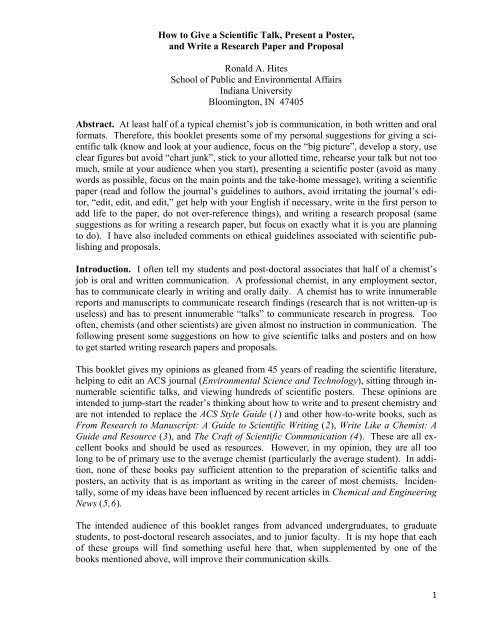

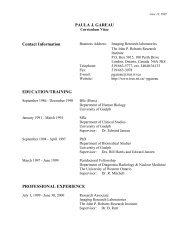

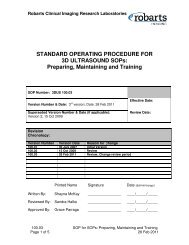
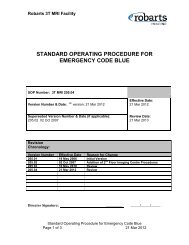


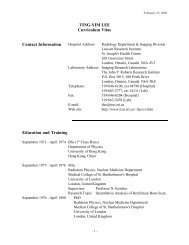

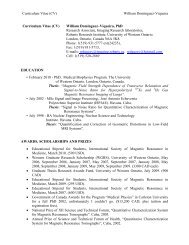

![how to read a scientific [journal] article - Robarts Imaging](https://img.yumpu.com/44345644/1/190x245/how-to-read-a-scientific-journal-article-robarts-imaging.jpg?quality=85)
